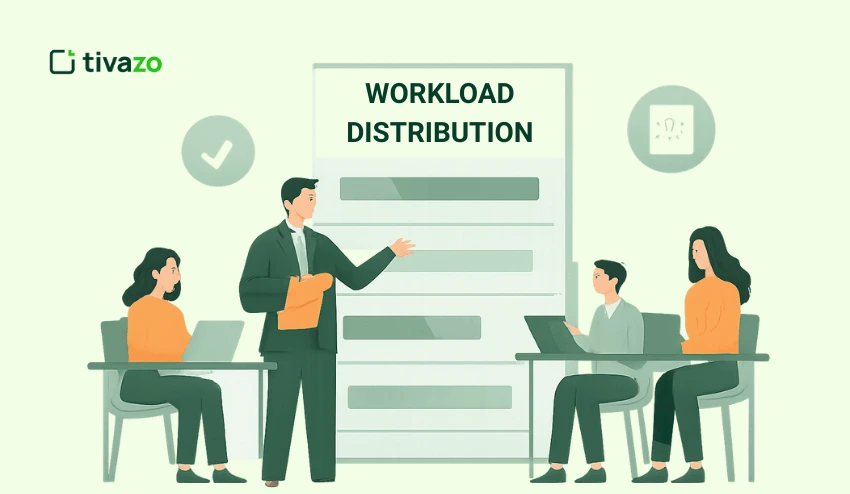As a Manager, distributing the workload of your team is by far one of the most difficult things you will do while it is also one of the most important things you need to do. If you load your workers with too much work you will quickly find them burned out, but if you give them too little work, you will fail to meet your expectations.
The concept that will lead you to a successful team is workload distribution. Workload distribution is the way in which you divide tasks to get your team to the right level of productivity.
In this blog, we will take a look at 7 tried and true methods that will change the way you distribute work and ultimately increase the efficiency of your teams. Let’s jump right in.
Key Highlights:
- What is Workload Distribution
- The Cost of Poor Management
- Strategies for Effective Workload Distribution
- Prevent Burnout with Proper Workload Balancing
- Workload Distribution Best Practices for Remote Teams
- Communicate Workload Expectations Clearly
What is Workload Distribution?
Workload distribution describes the assignment of tasks and responsibilities among team members based on their skills, workload, and capacity to take on new work. When done well, this will ensure that no one gets too busy, does too much, or falls behind on their work.
Here’s what can happen with poor workload distribution:
- Overworked employees contribute to burnout.
- Everyone has talent underutilized, which leads to frustration.
- Not enough focus on priority tasks.
When you balance the workload amongst your team, you increase productivity, create a healthier work environment, and help ensure that every individual is maximizing their contribution.
Why Workload Distribution Matters: The Cost of Poor Management
Workload distribution is very important to a productive and happy team. When workload distribution is poor, it affects a few things that can impact your team psychologically and performatively.
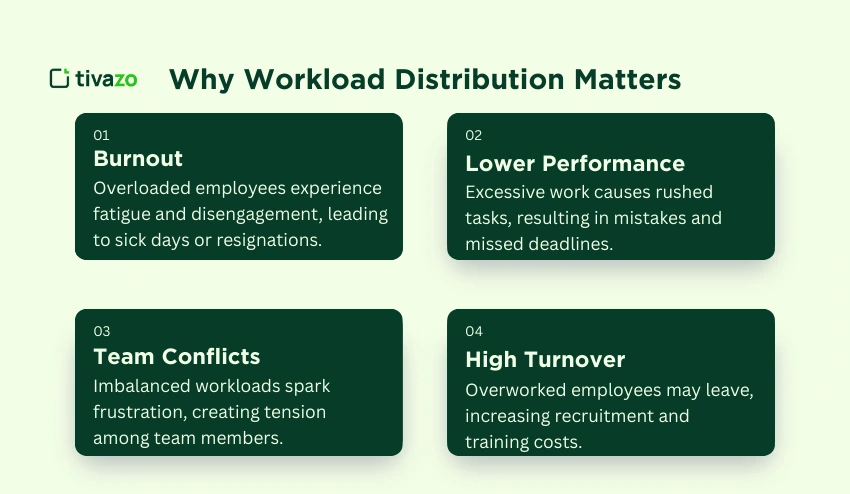
1. Burnout
When employees are overloaded, they become fatigued quickly and become disengaged. They experience burnout, where they feel fatigued and less motivated, which can cause employees to take more sick days and may even quit!
2. Lower Performance
When there is too much work, the quality decreases. Overworked employees cut through their work too quickly, which can result in more mistakes, missed deadlines, and, in general, all-around poor performance.
3. Team Conflicts
Workload distribution is often the root of conflict within a team. A particular employee may be overwhelmed with work and be frustrated with a colleague who has a lighter workload. This creates unnecessary frustration amongst an already stressed group.
4. High Turnover
Employees who are overworked and feel underappreciated are more likely to leave. If workloads are not balanced, this can lead to turnover, which is costly in recruitment and training time.
7 Proven Strategies for Effective Workload Distribution
Efficient workload distribution is one of the essential elements of keeping a productive and engaged team. A well-distributed workload ensures that employees are neither overworked nor underworked, which translates to improved performance, higher morale, and ultimately the long-haul stage of success. Here are seven proven methods to effectively distribute work to your team:
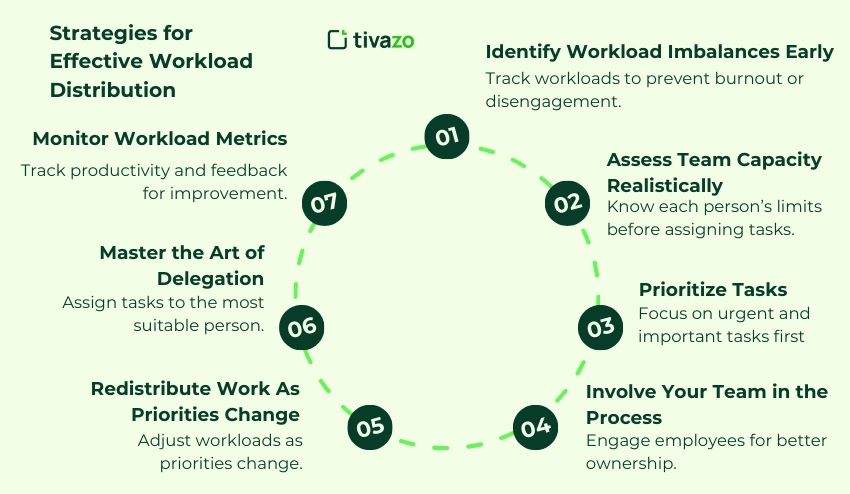
1. Identify Workload Imbalances Early
It is important to identify when someone is overworked or someone is underworked to avoid problems later. Overburdened employees may burn out. Employees who don’t have enough to do may not have the same sense of involvement. Recording workloads regularly can help catch discrepancies before they go rogue.
2. Assess Team Capacity Realistically
Before adding more work to someone’s plate, it is important to understand how much work that person and the team can reasonably handle. This includes not only project-specific work but also recurring responsibilities like meetings, emails, and admin work.
3. Prioritize Tasks Based on Urgency and Impact
Not all tasks are equal. By applying a prioritization framework to identify tasks that are both urgent and important, such as an Eisenhower Matrix, you can make sure your team attends to priorities. Low-priority tasks can be delegated or postponed.
4. Involve Your Team in the Process
Workload distribution is not a one-sided matter. Including your team in that process contributes to a sense of ownership and sense of responsibility. When they get to have a say in workload distribution, they take higher ownership of the outcome.
5. Redistribute Work As Priorities Change
Workload distribution is not a one-time task; it is a continuous process. You should constantly be able to check in with your employees and see how tasks are shifting as priorities change.
6. Master the Art of Delegation
Effectively delegating tasks is an important skill when balancing workloads. Assigning workload is not to be thought of as just randomly assigning tasks and hoping for the best outcome, but getting each task to the most appropriate person who can deliver the best outcome based on their skills and availability.
7. Monitor Workload Metrics for Continuous Improvement
Workload distribution is not a matter of ‘set and forget’. Tracking productivity measures, such as work hours, completion rates, employee feedback, and so on, allows you to find areas for potential improvement, and you can also be reassured that you are not overworking nor underworking your employees.
Optimizing Workload Distribution with Task Management Software
Task management software like Trello or Asana is an easy way to streamline workload distribution because it can keep your team on track and organized. It provides an interactive space for you to assign people tasks and responsibilities, track their progress, and set deadlines. It even provides a visually appealing website that keeps everyone up to date on their assignments.
Task management tools offer other great features like task prioritization and real-time updates, so you can identify when numbers are slipping and reassign someone who is overloaded with tasks.
How to Prevent Burnout with Proper Workload Balancing
Employees who are overloaded with work will feel burnout and disconnect. Avoid this by proactively managing workloads, and be sure that employees do not feel overloaded regularly.
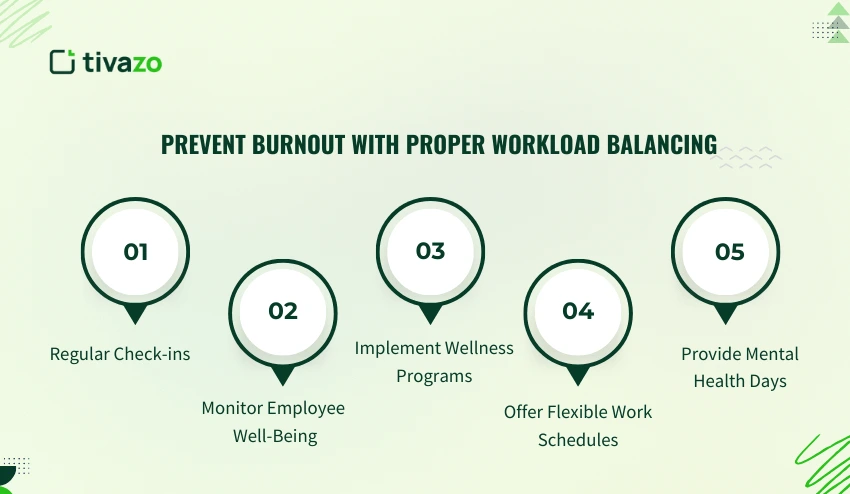
1. Regular Check-ins
- Have frequent one-on-one meetings with employees and ask how they feel about their workload.
- Ask them how they are coping, identify pain points, and let them know you are there to offer support.
2. Monitor Employee Well-Being
- Keep a pulse on stress and monitor for signs of burnout, including, but not limited to, increased absenteeism or a lack of attention to detail.
- Encourage an open-door policy to continue dialogue with your employees about issues or concerns?
3. Implement Wellness Programs
- Launch programs that focus on the holistic wellness of the employee with emphasis on physical and mental wellness, such as yoga classes, or a “wellness” workshop on stress management.
- Create a culture that promotes work-life balance and encourages employees to step away from work and unplug.
4. Offer Flexible Work Schedules
- Help employees have a better sense of control over their hours, especially in a remote or hybrid work environment.
- Offer a compressed workweek option, or flexible start and finish times, and other flexible options for how they complete hours to help ease stress.
5. Provide Mental Health Days
- Give employees focused, guilt-free time away from work to recharge and work on their mental health.
- Make sure employees understand their mental health is a priority by emphasizing it in your wellness program!
Workload Distribution Best Practices for Remote Teams
Remote team workload management can be tricky; however, the principles remain unchanged. You need effective communication, appropriate tools & good flexibility.
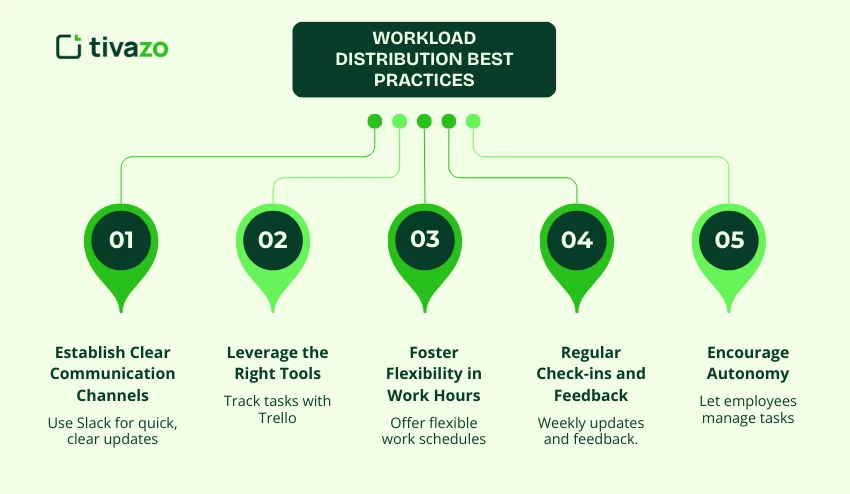
1. Establish Clear Communication Channels
Use a tool like Slack for clear, timely communication. Ensure your team understands expectations for responding.
2. Leverage the Right Tools
Utilizing a tool like Trello can help to manage and track how tasks are allocated, and to assess the balance of the team’s workload.
3. Foster Flexibility in Work Hours
Allow employees the flexibility of working hours to better contribute to their schedules (reduce pressure) and maximise contribution at work.
4. Regular Check-ins and Feedback
Check-ins on a weekly basis for the whole team and in a one-on-one basis with the team lead are important to openly discuss progress and where workloads can be adjusted.
5. Encourage Autonomy
Encourage employees to manage their own tasks and decisions. This increases employees’ feelings accountability, and their morale at work.
Leveraging Workload Analytics for Continuous Improvement
Workload analytics helps to monitor performance and see when team members haven’t been overloaded or ignored. With this information, you can manage workloads in real-time and ensure all team members contribute to a balanced, efficient team. And help everyone keep their productivity up. Checking in on these metrics regularly keeps you aware of any burnout issues and ensures the team keeps making progress on the larger project goals.
How to Communicate Workload Expectations Clearly
Expectations for workloads need to be communicated clearly. When employees don’t understand what’s expected of them or if it’s a priority or due next week, you can expect some confusion and lack of efficiency.
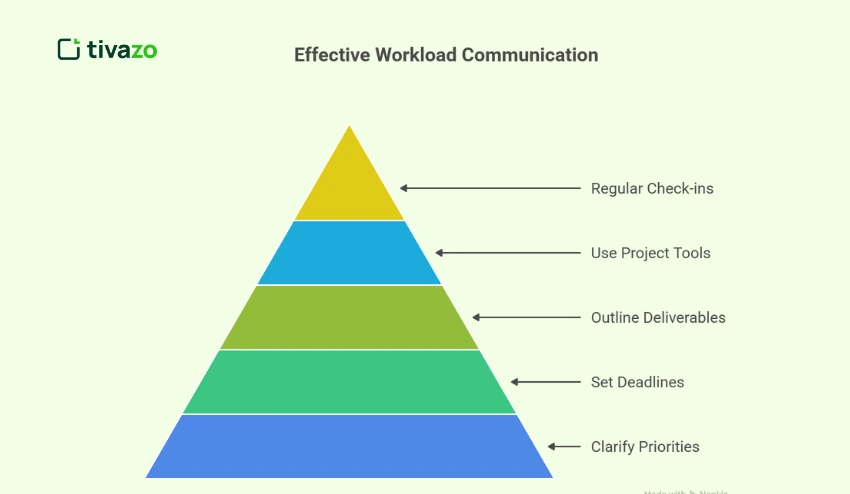
- Clarify priorities: Make sure to say which tasks are most critical.
- Set deadlines: Make sure to provide/agree on task due dates.
- Outline deliverables: Let everyone know the expected outcomes.
- Use project tools: Make sure everyone can track their tasks in project or team tools like Trello or Asana.
- Regular check-ins: Monitor progress and be able to solve undefined issues early.
Conclusion
Workload balancing is essential in achieving peak productivity, preventing burnout, and positively promoting our workplace. The 7 tactics we just covered are not only the best ways we’ve seen to help a team be more efficient, but also can help turn your team into more engaged and motivated employees.
Are you prepared to begin sharing your team’s work correctly? Use these tips to help your team become the well-rounded and efficient team you need.
